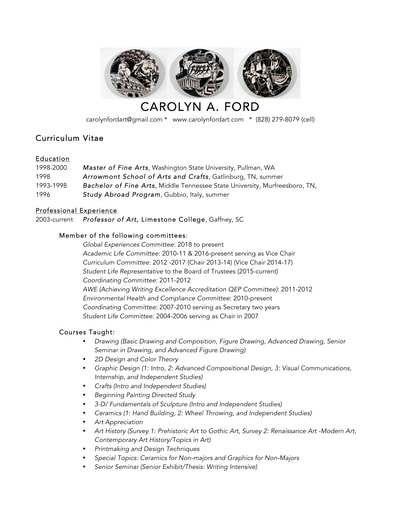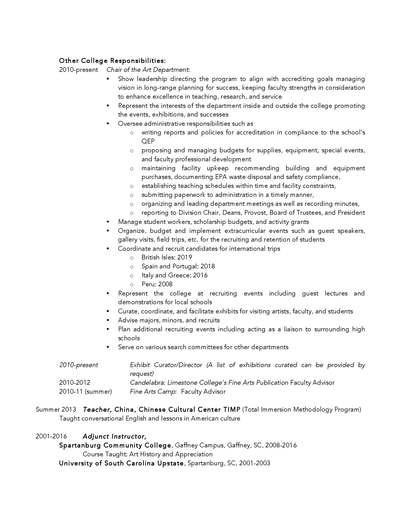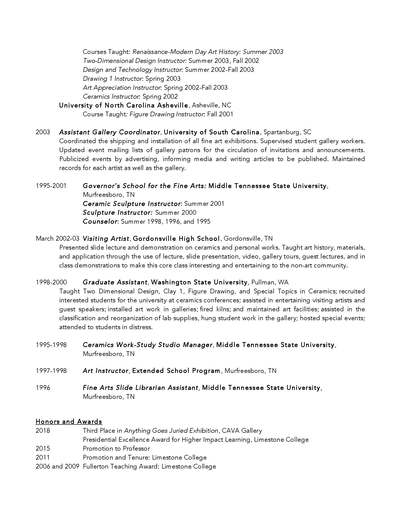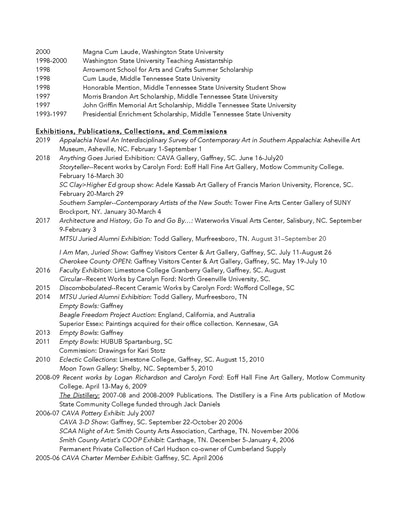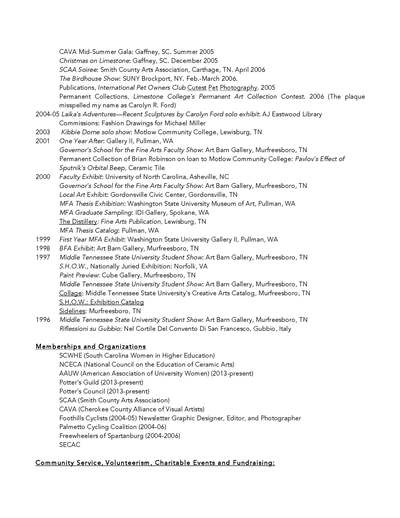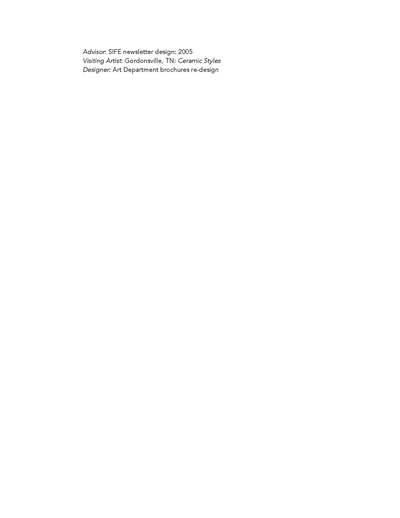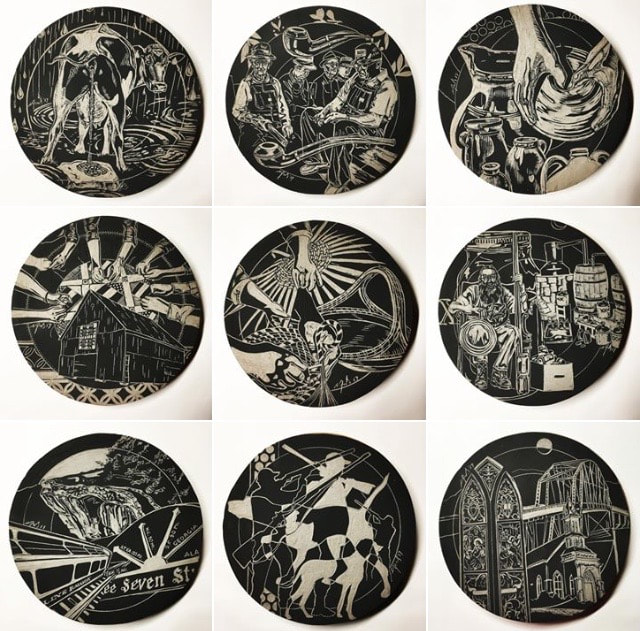It's a rat race (or a gerbil in a wheel). I stay super busy. My CV is forever changing. Please feel free to contact me for the most updated version.
Curriculum Vitae Updates not on pdf: *may be under construction with updates
Professional Experience
2003-current Professor of Art, Limestone University (previously College), Gaffney, SC
2010-2020 Chair of the Art Department and Gallery Director, Limestone University, Gaffney, SC
2021-present Art Department Program Manager, Limestone University, Gaffney, SC
2020: Exhibition Juror and Guest Speaker, SUNY Brockport, Brockport, NY
Honors and Awards
2021: Sabbatical and Artist in Residency at Mission Clay Art & Industry, Phoenix, AZ
Best in Show: GRIT, A1 Art Labs, Knoxville, TN
2020: Dr. Andrea Alison Outstanding Student Success Advocate Award
2018: Presidential Excellence Award for High Impact Practices
Exhibitions, Publications, Collections, and Commissions
2022 (Booked)
International Travels (public art): Drake’s Barn, Sacramento, CA
Woman's Work: Redefining Appalachian Traditions : Pam Miller Downtown Arts Center, Lexington, KY. March 11-April 30, 2022
The Crafted Narrative: Limestone University Gallery with juror Carrie Fee, Gaffney, SC. December 13-January 21, 2022
2021
Strained Separations: Reflections on a Pandemic: Tower Fine Arts Gallery at SUNY Brockport, NY. December 1-12, 2021
All Creatures Great and Small: Carthage Junction Depot, Gordonsville, TN. November 13, 2021.
Deck the Walls: CAVA Gallery, Gaffney, SC. November 5-December 31, 2021
Material Mugs VI: Underglaze: Companion Gallery with juror Michelle Ettrick, Humbolt, TN. September 10-October 31, 2021
Hella Cups: Applied Contemporary with jurors Jamie Bates and Justin Paik Reese, Oakland, CA. Sept. 3-October 23, 2021
A Place of Our Own: Limestone University Gallery, Gaffney, SC. August 23-October 8, 2021
Ceramics (2nd Annual): The In Art Gallery with juror Chase Gamblin. August 5-September 5, 2021
The Midas Touch: CAVA Gallery, Gaffney, SC. July-August 2021
GRIT: Emporium Center, Knoxville, TN. March-April 2021 (Best in Show)
This is Us: CAVA Gallery, Gaffney, SC. March 8-April 30, 2021
Last Call IV: Handmade Ceramics for Storing, Pouring, & Sipping Fine Libations: Companion Gallery (exhibit and publication), Humboldt, TN. March 5-April 15, 2021.
Faculty Show: Limestone University Granberry Gallery November 2020-January 2021
100th Anniversary for the Women’s Right to Vote: CAVA Gallery, Gaffney, SC. 11/2020-1/2021
2020
Guide: Group Invitational Exhibit at Limestone University, September-November 2020
Permanent Collection: Asheville Art Museum (acquisition of six works) January 2020
Permanent Collection: Mission Clay Art and Industry (visiting artist acquisition) January 2020
Speak My Language: Spartanburg Community College, Spartanburg, SC. August-December 2020
Appalachia Now! An Interdisciplinary: Asheville Art Museum, Asheville, NC. November 14, 2019-February 5, 2020
2019
Southernisms: Mission Clay Arts and Industry Permanent Collection, Phoenix, AZ. November 2019
Art Re Art: Pop Up Show, Morganton, NC. October 5
Anything Goes Again: A Peach Festival Art Exhibit, Gaffney Visitor’s Center and Art Gallery, Gaffney, SC. July 9-August 28
Black and White with a Pop: CAVA Gallery, Gaffney, SC. March-April
All Things Country Music: (Second Place) Cookeville Art Studio and Gallery, Cookeville, TN. January 5-February 5
CV
Teaching Philosophy
As an artist and educator, I believe in the idea of liberal studies, that art is a part of everything. Art enhances understanding of so many other studies and enriches our lives. My goal is to impart this idea when teaching. It is not that we simply do work because “we like it” or “it’s pretty.” Such statements are not allowed in my class encouraging the utilization of more fluent art vocabulary. Students should attempt to show creativity and originality, display craftsmanship, and defend their works during critique.
First, create good art experimenting with media and methods. Renaissance artists were not a “one trick pony.” The willingness to try new things and get out of a comfort zone, possibly getting dirty, is very important. One must have intellectual curiosity and the will to try and fail.
Second, incorporate the language of art through listening to instructor direction then applying through writing, testing, and critique. Eloquence of vocabulary can be carried into future studies. The correct application of artistic terms, media, methods, and rules create a foundation for furthering learning and understanding.
Third, Infuse history. It’s not only art history but also overall history that can enlighten students. What was the context that affected the content? What are the student’s surrounding like to mirror influences making art personal? To be inspired by the past is a springboard for their imagination.
Fourth, connect art and vocabulary to other disciplines. Allow non-majors to understand the value and rigor of art. Allow the majors to see how art utilizes math, science, history, music, and psychology in its process.
Fifth, utilize craftsmanship. Good craft comes from work. Great craft comes from harder work and a well-rounded understanding of how to truly manipulate the tools of the trade. “One and done” is not allowed for many projects.
Sixth, understand why we do what we do. Students need to synthesize the above to move on to the next level.
Finally, critique and be critiqued. Art is another form of sport. In order to achieve the highest level of greatness, one must be willing to grow, see flaws, and have the desire to improve in this competitive world. Not only can they listen to constructive criticism, they must also be able to identify strengths and weaknesses in others work and be willing to defend their works.
My methodology incorporates the above steps through demonstrations, lectures, hands-on assignments, out of class gallery visits, active group critique, and the use of purpose statements. Students write a summary of what the project is, why we do it (objectives), how we do it (media and methods), historical connections, and critique of self for each project. Assessment of student learning outcomes comes through specific project rubrics, purpose statements, and midterm and final exams.
I create a conducive teaching environment by fostering an open setting, encouraging growth, setting ambitious goals, allowing freedom for interpretation of assignments, and guiding individual learning styles. I act as a mentor and role model working alongside the students when needed. I love to play music and encourage laughter in class, get to know students as individuals, and promote discussion amongst classmates making a tight knit community of like-minded learners. I want the class to work as a group inspiring yet driving each other for greatness. I stress that learning comes just as much from the classroom as it does during the night studio hours with their classmates.
Sincerely,
Carolyn A. Ford
Limestone College Department Chair and Professor of Art
As an artist and educator, I believe in the idea of liberal studies, that art is a part of everything. Art enhances understanding of so many other studies and enriches our lives. My goal is to impart this idea when teaching. It is not that we simply do work because “we like it” or “it’s pretty.” Such statements are not allowed in my class encouraging the utilization of more fluent art vocabulary. Students should attempt to show creativity and originality, display craftsmanship, and defend their works during critique.
First, create good art experimenting with media and methods. Renaissance artists were not a “one trick pony.” The willingness to try new things and get out of a comfort zone, possibly getting dirty, is very important. One must have intellectual curiosity and the will to try and fail.
Second, incorporate the language of art through listening to instructor direction then applying through writing, testing, and critique. Eloquence of vocabulary can be carried into future studies. The correct application of artistic terms, media, methods, and rules create a foundation for furthering learning and understanding.
Third, Infuse history. It’s not only art history but also overall history that can enlighten students. What was the context that affected the content? What are the student’s surrounding like to mirror influences making art personal? To be inspired by the past is a springboard for their imagination.
Fourth, connect art and vocabulary to other disciplines. Allow non-majors to understand the value and rigor of art. Allow the majors to see how art utilizes math, science, history, music, and psychology in its process.
Fifth, utilize craftsmanship. Good craft comes from work. Great craft comes from harder work and a well-rounded understanding of how to truly manipulate the tools of the trade. “One and done” is not allowed for many projects.
Sixth, understand why we do what we do. Students need to synthesize the above to move on to the next level.
Finally, critique and be critiqued. Art is another form of sport. In order to achieve the highest level of greatness, one must be willing to grow, see flaws, and have the desire to improve in this competitive world. Not only can they listen to constructive criticism, they must also be able to identify strengths and weaknesses in others work and be willing to defend their works.
My methodology incorporates the above steps through demonstrations, lectures, hands-on assignments, out of class gallery visits, active group critique, and the use of purpose statements. Students write a summary of what the project is, why we do it (objectives), how we do it (media and methods), historical connections, and critique of self for each project. Assessment of student learning outcomes comes through specific project rubrics, purpose statements, and midterm and final exams.
I create a conducive teaching environment by fostering an open setting, encouraging growth, setting ambitious goals, allowing freedom for interpretation of assignments, and guiding individual learning styles. I act as a mentor and role model working alongside the students when needed. I love to play music and encourage laughter in class, get to know students as individuals, and promote discussion amongst classmates making a tight knit community of like-minded learners. I want the class to work as a group inspiring yet driving each other for greatness. I stress that learning comes just as much from the classroom as it does during the night studio hours with their classmates.
Sincerely,
Carolyn A. Ford
Limestone College Department Chair and Professor of Art
References
Brett Schenning
Instructor of Art
Art Department at Limestone College
[email protected]
Cell: (928) 380-9409
Emily Tuttle
Adjunct Art Historian
Art Department at Limestone College
[email protected]
Cell: (843) 359-2006
Dr. Gena Poovey
Direct Supervisor
Professor of Music
Dean of Arts and Letters at Limestone College
[email protected]
Office: (864) 488-4509
Dr. Youmi Efurd
Curator and Cultural Arts Coordinator
Wofford College
[email protected]
Office: (864) 597-4585
Dr. M. Felicia Cavallini
Fulbright Scholar and Professor of Physical Education
Limestone College
[email protected]
Dr. Jonathan Sarnoff
Director of the Honors Program and Professor of History
Limestone College
[email protected]
Brett Schenning
Instructor of Art
Art Department at Limestone College
[email protected]
Cell: (928) 380-9409
Emily Tuttle
Adjunct Art Historian
Art Department at Limestone College
[email protected]
Cell: (843) 359-2006
Dr. Gena Poovey
Direct Supervisor
Professor of Music
Dean of Arts and Letters at Limestone College
[email protected]
Office: (864) 488-4509
Dr. Youmi Efurd
Curator and Cultural Arts Coordinator
Wofford College
[email protected]
Office: (864) 597-4585
Dr. M. Felicia Cavallini
Fulbright Scholar and Professor of Physical Education
Limestone College
[email protected]
Dr. Jonathan Sarnoff
Director of the Honors Program and Professor of History
Limestone College
[email protected]
